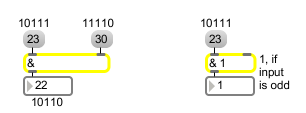Examples

Nonzero bits shared by both numbers........ Can be used as an odd/even detector
Bitwise intersection of two numbers
| Name | Type | Opt | Description |
|---|---|---|---|
| initial-value | int | opt | Sets an initial value to be compared with a number received in the left inlet. |
| bang | In left inlet: Performs the comparison with the numbers currently stored. If there is no argument, & initially holds 0 for comparison. | |
| int | input [int] |
In left inlet: The number is compared, in binary form, with the number in the right inlet. The output is a number composed of those bits which are 1 in both numbers. |
| (inlet1) | comparison-number [int] |
In right inlet: The number is stored for comparison with a number received in the left inlet. |
| float | input [float] |
Converted to . |
| set | set-input [int] |
In left inlet: The word followed by a number will set the input to the bitwise-and operation without causing output (a successive will output the result). |
| list | input [list] |
In left inlet: Compares the first and second numbers bit-by-bit, and outputs a number composed of those bits which are 1 in both numbers. |

| Name | Description |
|---|---|
| && | If both numbers are non-zero, output a 1 |
| | | Bitwise union of two numbers |
| || | If either of two numbers is non-zero, output a 1 |
| Max Basic Tutorial 19: Timing | Max Basic Tutorial 19: Timing |